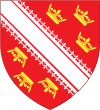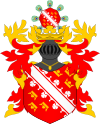
The Alemanni or Alamanni were a confederation of Germanic tribes on the Upper Rhine River during the first millennium. First mentioned by Cassius Dio in the context of the campaign of Roman emperor Caracalla of 213, the Alemanni captured the Agri Decumates in 260, and later expanded into present-day Alsace and northern Switzerland, leading to the establishment of the Old High German language in those regions, which by the eighth century were collectively referred to as Alamannia.
This article concerns the period 19 BC – 10 BC.
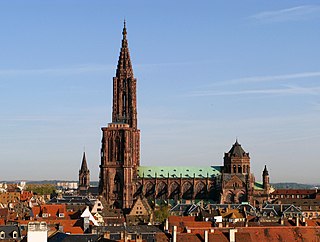
Strasbourg is the prefecture and largest city of the Grand Est region of eastern France and the official seat of the European Parliament. Located at the border with Germany in the historic region of Alsace, it is the prefecture of the Bas-Rhin department.

Legio VIII Augusta was one of the oldest legions of the Imperial Roman army.
Legio I Germanica,, was a legion of the Imperial Roman army, possibly founded in 48 BC by Julius Caesar to fight for him in the civil war against Pompey. The title germanic is a reference to its service in the Germanic Wars, rather than the place of origin of its soldiers. After the Revolt of the Batavi, the remaining men of the Germanica were added to Galba's seventh legion, which became VII Gemina. The emblem of Legio I is unknown, but it was probably Taurus, like all the other legions levied by Caesar.

The Revolt of the Batavi took place in the Roman province of Germania Inferior between AD 69 and 70. It was an uprising against the Roman Empire started by the Batavi, a small but militarily powerful Germanic tribe that inhabited Batavia, on the delta of the river Rhine. They were soon joined by the Celtic tribes from Gallia Belgica and some Germanic tribes.
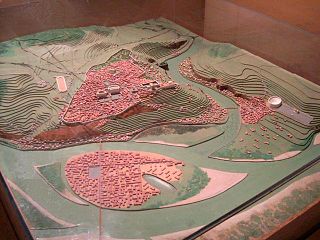
Lugdunum was an important Roman city in Gaul, established on the current site of Lyon. The Roman city was founded in 43 BC by Lucius Munatius Plancus, but continued an existing Gallic settlement with a likely population of several thousands. It served as the capital of the Roman province of Gallia Lugdunensis and was an important city in the western half of the Roman Empire for centuries. Two emperors, Claudius and Caracalla, were born in Lugdunum. In the period 69–192 AD, the city's population may have numbered 50,000 to 100,000, and possibly up to 200,000 inhabitants.
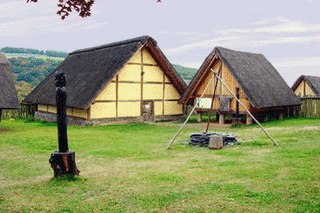
The Trēverī were a Celtic tribe of the Belgae group who inhabited the lower valley of the Moselle from around 150 BCE, if not earlier, until their displacement by the Franks. Their domain lay within the southern fringes of the Silva Arduenna, a part of the vast Silva Carbonaria, in what are now Luxembourg, southeastern Belgium and western Germany; its centre was the city of Trier, to which the Treveri give their name. Celtic in language, according to Tacitus they claimed Germanic descent. They possibly contained both Gallic and Germanic influences.

This is a chronology of warfare between the Romans and various Germanic peoples between 113 BC and 476. The nature of these wars varied through time between Roman conquest, Germanic uprisings and later Germanic invasions of the Western Roman Empire that started in the late second century BC. The series of conflicts was one factor which led to the ultimate downfall of the Western Roman Empire in particular and ancient Rome in general in 476.
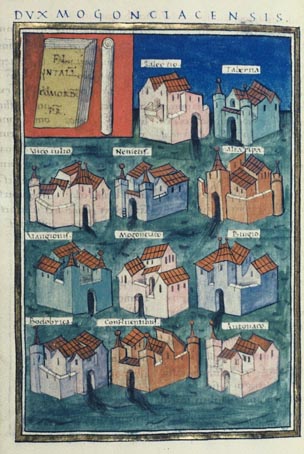
The Vangiones appear first in history as an ancient Germanic tribe of unknown provenance. They threw in their lot with Ariovistus in his bid of 58 BC to invade Gaul through the Doubs river valley and lost to Julius Caesar in a battle probably near Belfort. After some Celts evacuated the region in fear of the Suebi, the Vangiones, who had made a Roman peace, were allowed to settle among the Mediomatrici in northern Alsace.. They gradually assumed control of the Celtic city of Burbetomagus, later Worms.

The Viromanduī or Veromanduī were a Belgic tribe dwelling in the modern Vermandois region (Picardy) during the Iron Age and Roman periods. During the Gallic Wars, they belonged to the Belgic coalition of 57 BC against Caesar.

The Rauraci or Raurici were a small Gallic tribe dwelling in the Upper Rhine region, around the present-day city of Basel, during the Iron Age and the Roman period.

Mirebeau-sur-Bèze is a commune in the Côte-d'Or department in eastern France.

Germania was a short-lived Roman province for the duration of 16 years under Augustus, from 7 BC to AD 9. The possible capital of this province was Marktbreit, a castrum with a nearby canaba from the period of Emperor Augustus, located 70 km east of the "Limes Germanicus" on the River Main.

The Musée archéologique of Strasbourg, France is the largest of the numerous Alsacian museums displaying regional archeological findings from Prehistory to the Merovingian dynasty. It is located in the basement of the Palais Rohan.

In classical antiquity, the Triboci or Tribocci were a Germanic people of eastern Gaul, inhabiting much of what is now Alsace.
The following is a timeline of the history of the city of Strasbourg, Alsace, France.

Strasbourg is a city in the historic Alsace region on the left bank of the Rhine. Founded by the Romans in 12 BC, the city passed under the control of the Merovingians in the eighth century, and then became part of the Holy Roman Empire. Flourishing throughout the middle ages and Renaissance, it was conquered by Louis XIV in 1681. After having changed nationality four times between 1870 and 1945, Strasbourg today is a symbol of Franco-German reconciliation and European integration. The following is a detailed history of Strasbourg, France.

Caius Largennius was a legionary of the Legio II Augusta. A scion of the gens Fabia, he was born in Lucca and stationed in Argentoratum. His funerary stele, discovered in 1878 in the Strasbourg district of Koenigshoffen, has been much studied and is well documented. It is now kept in the Musée archéologique de Strasbourg.
The history of Alsace has been influenced by the Rhine and its tributaries, a favorable climate, fertile loess soils, and the region's relative accessibility through and around the Vosges. It was first inhabited by early modern humans during the Paleolithic. Peoples speaking Celtic and Germanic languages occupied the region prior to its conquest by Roman armies under the command of Julius Caesar. In the centuries after the fall of Rome the area acquired its name and identity as an early medieval pagus. Since then, legal suzerainty and effective control has shifted among competing European powers, including the Kingdom of Alamannia, the Frankish Empire, Lotharingia, the Holy Roman Empire, France, and the German Empire. Alsace has remained part of France since the end of the Second World War.



















